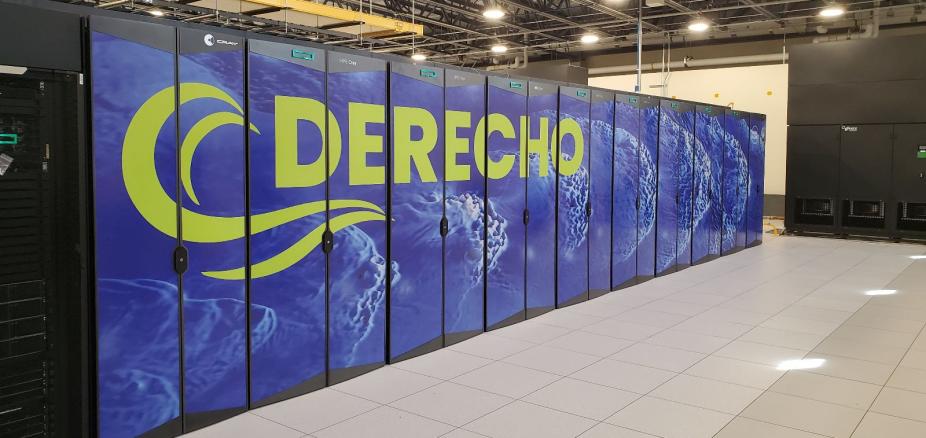
By Samir Knox
Wyoming Tribune Eagle
Via- Wyoming News Exchange
CHEYENNE — The brand new Derecho supercomputer, located at the National Center for Atmospheric Research-Wyoming Supercomputing Center, could put climate scientists on the cusp of better predicting natural disasters and fighting climate change, researchers said Friday.
“This type of environmental intelligence is critical to farmers, ranchers, energy producers, shipping companies and, in essence, every single sector of our economy,” Antonio Busalacchi, president of the University Corporation for Atmospheric Research, said at the computer’s inauguration. “Scientists are also using Derecho to better understand extreme weather and other events that threaten many of our communities. As we’ve tragically seen in the last several days, changes in our climate system are contributing to disasters, such as the wildfires in Maui that (have) caused more than 100 deaths so far.
“Scientists need to, increasingly, turn to powerful computers to improve our ability to predict such events.”
Derecho is the third-generation supercomputer operating at the NCAR center in Cheyenne in the past 11 years.The first model, called Yellowstone, was active at the supercomputer center west of the city from 2012 to 2017.
The second supercomputer, called Cheyenne, began operating in 2016 and will be phased out within the next six months.
The Derecho model boasts the ability to be three times as fast as the Cheyenne computer while only consuming 40% more energy. NCAR Director Everette Joseph had a unique way of putting the Derecho computer’s 19.87 petaflops of computing power into perspective.
“Theoretically, it has the ability to carry out that many calculations, 19.87 quadrillion calculations per second,” Joseph said. “It would take every adult and child on the planet one month to make that many calculations if they solved one calculation a second in that whole month.”
Flops are a measurement of calculations per second, and one petaflop indicates a quadrillion calculations per second. For researchers who will use the supercomputer to study the atmosphere, this amount of speed can allow them to tackle visual modeling in a way the Yellowstone and Cheyenne computers weren’t able to.
“More than 6,500 users from more than 650 universities across the U.S. have used the resources of this center,” Joseph said. “This has resulted in nearly 7,000 peer-reviewed publications, dissertations, theses and other works. … I’m really proud of this record, really proud of this facility … and I’m really excited for the incredible research to come from this incredible system that we have the fortune of being able to deploy.”
Irfan Elahi, director of the NCAR high-performance computing division, directly oversees the Cheyenne facility and will be responsible for research management of the Derecho computer going forward.
“I think a lot is changing,” Elahi told the Wyoming Tribune Eagle. “We need to keep up with the times because, ultimately, our goal is to provide the best value for our researcher — (to make) the best performance system that reduces complexity, increases productivity and enhances usability.”
The partnership with NCAR to locate a supercomputer in Cheyenne was initially approved by the Wyoming Legislature in 2007. One of the state legislators serving at the time was now-U.S. Sen. John Barrasso, R-Wyo.
During Friday’s ceremony, Barrasso read directly from the text of the budget amendment that approved the NCAR facility in Cheyenne. The bill said that the intent of the program was “to enhance the University of Wyoming’s research capability, in general, and strengthen the university’s School of Energy Resources, in particular.”
The initiation ceremony also showcased bipartisan support for the supercomputer project and the mission of climate research.
Kei Koizumi, principal deputy director for policy at the White House Office of Science and Technology Policy, thanked President Joe Biden and Vice President Kamala Harris in his remarks.
“The United States will be better prepared for tomorrow’s environmental disasters,” Koizumi said. “We’ll be better able to model and predict weather and climate change. Importantly for our commitment to environmental justice, providing more fine-grained insights on the environment at the community level … so that we can better understand how weather and climate are affecting each of our many communities.”
Gov. Mark Gordon, who also spoke at the event, said the new supercomputer would help break new ground in getting better models for understanding natural disasters.
“Wyoming is really trying to lead the nation in solutions on carbon dioxide in the atmosphere,” Gordon said. “… We have some models, but we don’t have good answers. … But now, we have computing power to really begin to understand and to crack open these questions. Wyoming intends to be a leader in this field.”
Hewlett Packard General Manager Justin Howard commended the innovation all the institutions that use the computer have made since the company got involved. HP was involved in making both the Derecho and Cheyenne supercomputers.
The name of the computer, “Derecho,” was chosen by Riverton high schooler Cael Arbogast. In weather terms, “derecho” usually describes a group of heavy wind or rain storms that travel rapidly across a large distance.
“I remember … being in eighth grade and trying to think of a cool name,” he said. “I went home, and I’m laying on the floor in the living room, and I went, ‘Well, what is this computer going to do? This computer is going to help all over the world, all over the country, just learning and adapting to so many new things.’
“I found Derecho because it’s intense, it’s fast, and that’s kind of how weather is and how we, as humans, should be innovating.”




